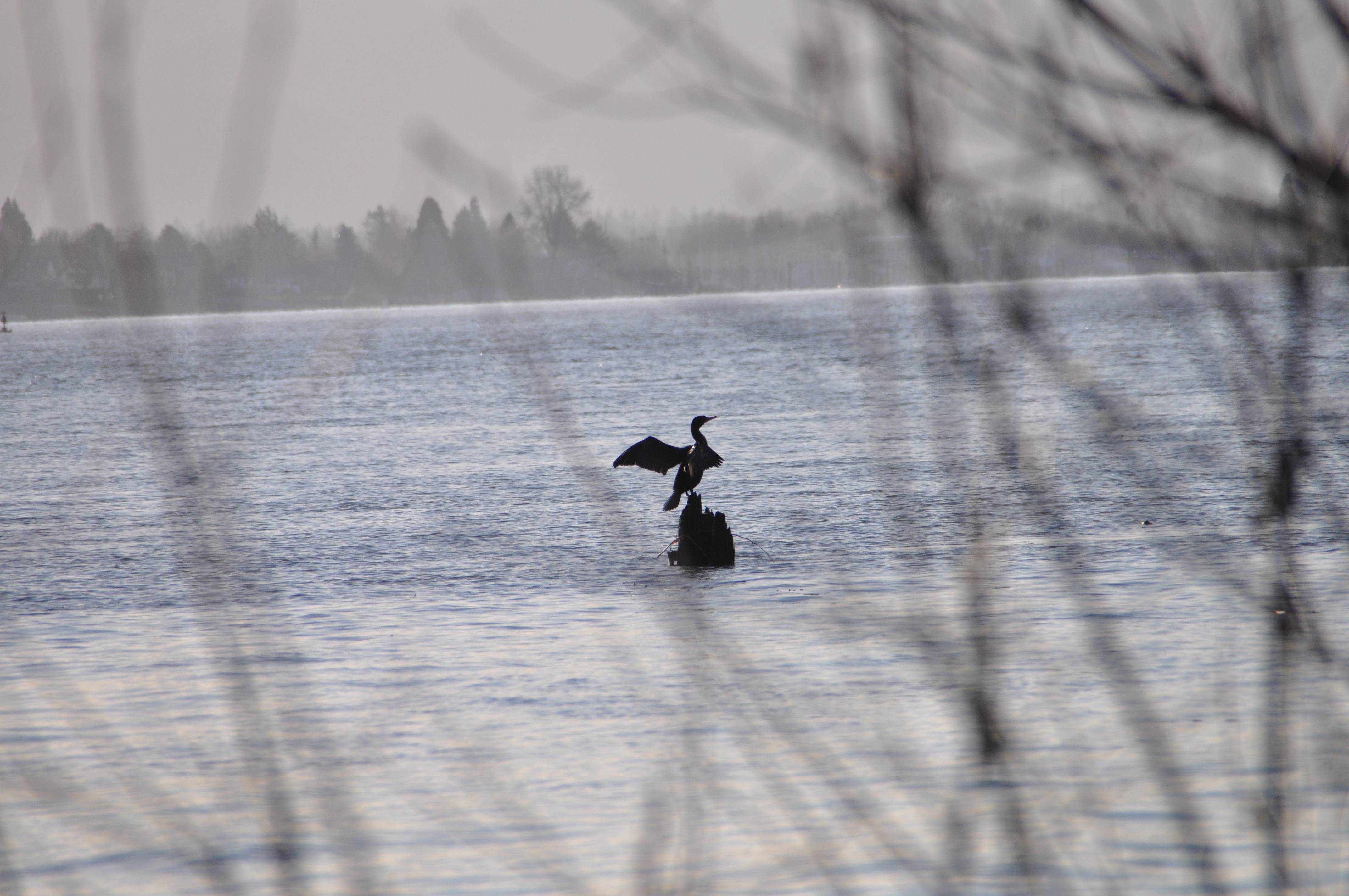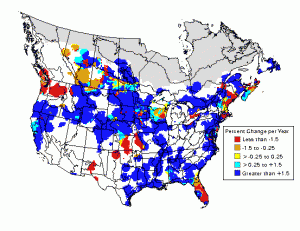
Double-crested Cormorant (Phalacrocorax auritus) in Lake Merritt Oakland, CA USA.
Date 03/04/07
Source Own work
Author Calibas
Order: Suliformes
Family: Phalacrocoraidae
Genus: Phalacrocorax
Species: Phalacrocorax auritus
Introduction The Double-crested Cormorant Phalacrocorax auritus (DCCO) is the most common cormorant seen on The Evergreen State College (TESC) campus coastline. The Brandt’s and Pelagic Cormorants are a rare sighting on the beaches of TESC. Of the three species, only the DCCO is commonly encountered in both salt and fresh inland waters, the other two are encountered on more open waters of the sound and the ocean. The Double-crested Cormorant is a diving bird feeding on schooling fish at mid depths. The DCCO may commonly be seen holding its wings out, this is to dry them off after diving. Populations are abundant and are perceived as a pest to some. The Double-crested Cormorant is about 33″ inches long, with a wing span of 52″ inches, and weighs 3.7 pounds. Juveniles are brownish, and the adults are almost black. They have an orange-ish yellow throat (Sibley, 2003).
The Double-crested Cormorant can be in both salt water and fresh water environments, and prefers calm to moderate current water. In a report on diving birds in strong tidal areas, both the Brandt’s and the Pelagic Cormorants were commonly found, but the Double-crested was rarely seen in the rough waters (Holm & Burger, 2002). The DCCO is a colony nester and prefers islands and sheltered beach areas to nest (Wild, 2012) (Wires & cuthbert, 2010).
Sound of DCCO taking off the water runningMichelettiM_DCCO_takeoffsound_11302012_1257_47-0870_-122-9746
On the campus beach, the cormorant’s feeding is mostly a solo endeavor. At the NNWR, the Double-crested Cormorant has been seen feeding in small groups of five to eight birds (Stacey, 2012). During the breeding season, DCCO are more likely to be observed feeding in larger groups in a bimodal pattern, at dawn and mid-afternoon. They require a relatively small abundance of food, even in the breeding season (Coleman, & Richmond, 2007).
Cormorants swim with their feet and not with their wings, they are seasonal monogamous breeders. The DCCO lay between 3-7 eggs (4 is the mean), 28 days to incubate, and 49 days more to fledgling (Johnsgard,1993).
Current population densities make this less of a concern in the Pacific Northwest. Historically the DCCO was viewed as a pest and rigorous efforts were made to eliminate them. It is known that as eary as the 1600s DCCO populations were vast. Those populations were in fact so large that there were concerns over fish populations (Wires and Cuthbert, 2006). In the Columbia River basin migrating smolts, a food source for the DCCO, were listed as threatened or endangered on the U.S. Endangered Species Act (Anderson, Roby, & Collis, 2004). In the Great Lakes, toxic contaminates had nearly eliminated the DCCO by the early 1970s. However, recovery efforts, as well as an increase in fish abundance allowed the DCCO to significantly recover. In 1972, there were approximately 135 breeding pairs of DCCO in the Great Lakes region. By 2000 those numbers had magnified to 115,000. It is possible that the expansion of aquaculture and an increase in fish communities may have altered the breeding capacity of the DCCO, leading to the overwhelming population increase. This increase has created human and waterbird competition for fish, and caused damage to the vegetation of their local habitat (Guillaumet, Dorr, Wang, & Doyle, 2014). The Pacific Northwest has had uneven DCCO populations with site specific growth. The Columbia River estuary at East Sand Island (ESI) experienced a similar population climb as that of the Great Lakes region. In 1989 there were fewer than 100 breeding pairs at the ESI, but in 1991 there were more than 2,000 pairs. In 2009 there were an estimated 12,087 pairs. The ESI has 40% of the Pacific Northwest breeding DCCO population. Unlike the Great Lakes region, it is believed that this is purely the result of migration. However, as in the Great Lakes region, there is concern for the salmonid populations, which are also listed on the Endangered Species List (Courtot, Roby, Adkins, Lyons, King, & Larsen, 2012).
Credit: U.S. Geological Survey, Department of the Interior, http://www.usgs.govSurvey
This trend map from the Breeding Bird Survey website shows the nationwide increase of the DCCO between 1966-2011.
With the increase in Double-Crested Cormorant populations and the conflict with threatened or endangered fish, management strategies have been put into place to lessen the density of the DCCO population, thereby, lessening the conflict with the fish. These management strategies could have a far reaching impact on the DCCO, as these management decisions are made on the local level and do not take into account the range-wide implications. The cumulative effects of management are being researched, and more research is needed in this area (Guillaumet, Dorr, Wang, & Doyle, 2014).
Anderson, C. D., Roby, D. D., & Collis, K. (2004). Conservation Implications of the Large Colony of Double-Crested Cormorants on East Sand Island, Columbia River Estuary, Oregon, U.S.A. Waterbirds: The International Journal of Waterbird Biology, 27(2), 155–160.
Bovy, K. M. (2011). Archaeological Evidence for a Double-crested Cormorant Colony in the Pacific Northwest, USA. Waterbirds , 89-95.
Clark, A. C., Kollasch, T. M., & Williamson, D. A. (2006, Autumn). Movements of Double-crested Cormorants Fledged on the Columbia River Estuary. Retrieved October 19, 2012, from Bio One Research Evolved: http://www.bioone.org/doi/full/10.1898/1051-1733%282006%2987%5B150%3AMODCFO%5D2.0.CO%3B2
Coleman, J. T. H., & Richmond, M. E. (2007). Daily Foraging Patterns of Adult Double-Crested Cormorants during the Breeding Season. Waterbirds: The International Journal of Waterbird Biology, 30(2), 189–198.
Courtot, K. N., Roby, D. D., Adkins, J. Y., Lyons, D. E., King, D. T., & Larsen, R. S. (2012). Colony Connectivity of Pacific Coast Double-Crested Cormorants Based on Post-Breeding Dispersal From the Region’s Largest Colony. The Journal of Wildlife Management, 76(7), 1462–1471.
Ehrlich, P. R., Dobkin, D. S., & Wheye, D. (1988). The Birder’s Handbook: A field guide to the natural history of North American birds. United States of America: Simon and Schuster Inc.
Guillaumet, A., Dorr, B. S., Wang, G., & Doyle, T. J. (2014). The cumulative effects of management on the population dynamics of the Double-crested Cormorant Phalacrocorax auritus in the Great Lakes. Ibis, 156(1), 141–152.
Hatch, J. J., & Weseloh, D. V. (1999). Double-crested Cormorant (Phalacrocorax auritus). Retrieved November 16, 2012, from The Birds of North America Online: : http://0-bna.birds.cornell.edu.cals.evergreen.edu/bna/species/441
Holm, K. J., & Burger, A. E. (2002). Foraging Behavior and Resource Partitioning by Diving Birds During Winter in areas of Strong Tidal Currents. Waterbirds , 312-325.
Johnsgard, P. A. (1993). Cormorants, Darters, and Pelicans of the World. Washington DC: Smithsonian Institution Press.
Jordon, M., & Paulson, D. (2009, Spring). Wing-spreading Behavior in Pacific Cormorants. Retrieved October 19, 2012, from BioOne Research Evolved: http://www.bioone.org/doi/full/10.1898/1051-1733-90.1.39
Sibley, D. A. (2003). The Sibley Field Guide to Birds of Western North America. New York: Random House, Inc.
Sibley, D. A. (2009). The Sibley Guide to Bird life and Behavior. New York: Andrew Stewart Publishing Inc.
Stacey, M. S. (2012). Field Notebook Ornithology Fall 2012. Edgewood : none.
Wild, D. (2012). The Double-crested Cormorant (Symbol of Ecological Conflict). Ann Arbor: University of Michigan.
Wires, L. R., & Cuthbert, F. J. (2006). Historic Populations of the Double-Crested Cormorant (Phalacrocorax auritus): Implications for Conservation and Management in the 21st Century. Waterbirds: The International Journal of Waterbird Biology, 29(1), 9–37.
Wires, L. R., & Cuthbert, F. J. (2010). Characteristics of Double-crested Cormorant Colonies in the U.S. Great Lakes Island Landscape. Journal of Great Lakes Research, 232-241.
Loba Azul is at home in wild places. Loba is a certified wildlife rehabber and has spent many years following their passion for nature. Loba is the founder of Wolfwild (wolfwild.org), an organization that advocates for captive and wild wolves and wolf dogs.



Leave a Reply